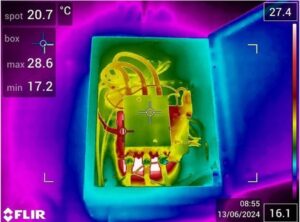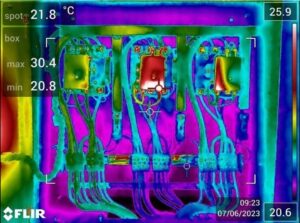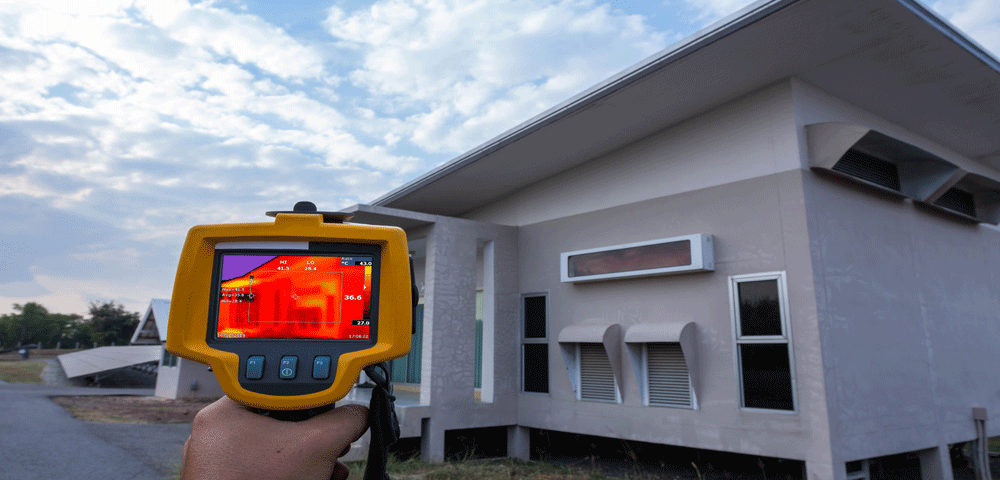Preparing for Electrical Thermal Imaging Inspection
There are many items to consider when preparing for an electrical thermal imaging inspection. The following article helps to explain how we (and our clients) need to prepare for an electrical thermal imaging survey to their building’s:
Site Preparation
- Select the Right Thermal Camera: We always ensure our infrared camera has the necessary resolution and sensitivity for electrical inspections. We only use high resolution and sensitivity cameras to ensure the best images and data are captured during our infrared inspections.
- Safety Gear: We always wear appropriate personal protective equipment (PPE) such as gloves, safety glasses, and insulated clothing.
- Inspection Plan: Outline the areas and components to be inspected, including electrical panels, switchgear, transformers, and wiring. This is agreed with our clients before we attend site to ensure nothing is missed during the inspection.
- Thermal imaging checklist: Ensure our clients have a copy of our electrical thermal imaging checklist so they can be prepared for our site inspection visit.

Thermal Imaging to Electrical systems
- Systematic infrared Inspection: Perform a systematic thermal imaging inspection of all electrical components. Inspect all electrical outlets, switches, and service panels for anomalies or hot spots.
- Document Findings: Record any anomalies, hot spots, or unexpected thermal patterns.
Common electrical problems that can be detected
Here are some common problems that can be detected during our inspection:
- Electrical Hot Spots: Areas that are significantly hotter than their surroundings, indicating potential issues like overloaded circuits or faulty components.
- Loose or Corroded Connections: These can cause increased resistance and heat, leading to potential failures or fire hazards.
- Overloaded Electrical Circuits: Circuits carrying more current than they are designed for can overheat and fail.
- Faulty Electrical Components: Defective parts such as transformers, motors, or capacitors can generate excess heat.
- Breaker and Wire Crimp Issues: Poorly crimped wires or faulty breakers can show up as hot spots.
- Electrical Current Unbalance: Uneven distribution of electrical load can cause overheating in certain parts of the system.
Any of the above issues, if left unchecked, can lead to significant safety hazards, including electrical failures and fires. Regular thermal imaging inspections can help in early detection and prevention.
Post-infrared Inspection
- Analyse Data: Review and analyse the thermal images and data collected.
- Report Findings: Prepare a detailed report with visual proof of any issues detected.
- Recommendations: Provide recommendations for repairs or further investigation based on the findings.

What happens if we detect hotspots
If we detect a hot spot during a thermal imaging survey, we let our clients know so they can action the following pathway:
- Identify the cause of the hotspot: so clients can check if the hot spot is due to a loose connection, overloaded circuit, or faulty component.
- Always ensure a safety-first approach: you should always ensure the area is safe before proceeding with any repairs or inspections. Turn off the power to the affected circuit if necessary.
- Inspect and repair: Have a qualified electrician inspect the hot spot. They may need to tighten connections, replace faulty components, or redistribute the load as necessary.
- Document the Issue: Record the location, temperature, and any other relevant details of the hot spot for future reference, as this can help with trend analysis of components etc.
- Re-test the hotspot areas: After repairs have been made to the electrical system, perform another electrical thermal inspection to ensure the issue has been fully resolved.
It’s crucial to address hot spots promptly to prevent potential hazards like electrical fires or equipment failure. If you’re unsure about any step, please get in touch and we can explain the benefits of a thermal imaging survey.

Don’t Ignore electrical hot spots
Ignoring hot spots in electrical systems can lead to several serious risks:
- Electrical Fires: Hot spots can cause insulation to degrade, leading to short circuits and potentially catastrophic fires putting lives and buildings at risk.
- Equipment Failure: Overheating can damage electrical components, leading to unexpected equipment failures and costly repairs to critical infrastructure.
- Electrocution: Faulty wiring or connections that cause hot spots can increase the risk of electric shocks leading to injuries and/or loss of life.
- Increased Energy Consumption: Overheating components often operate less efficiently, leading to higher ongoing energy usage and costs.
- Property Damage: Electrical fires and equipment failures can cause significant damage to property, resulting in expensive repairs and potential loss of valuable assets.
Addressing hot spots promptly is crucial to maintaining safety and preventing these risks. If we detect a hot spot, it’s best to consult a qualified electrician to inspect and resolve the issue in a quick and safe manner.
If you would like more information on our thermal imaging inspection service, please contact APT Sound Testing on 07775 623464 or email us at info@airpressuretesting.net
If you have any specific questions or need further details, feel free to ask.
